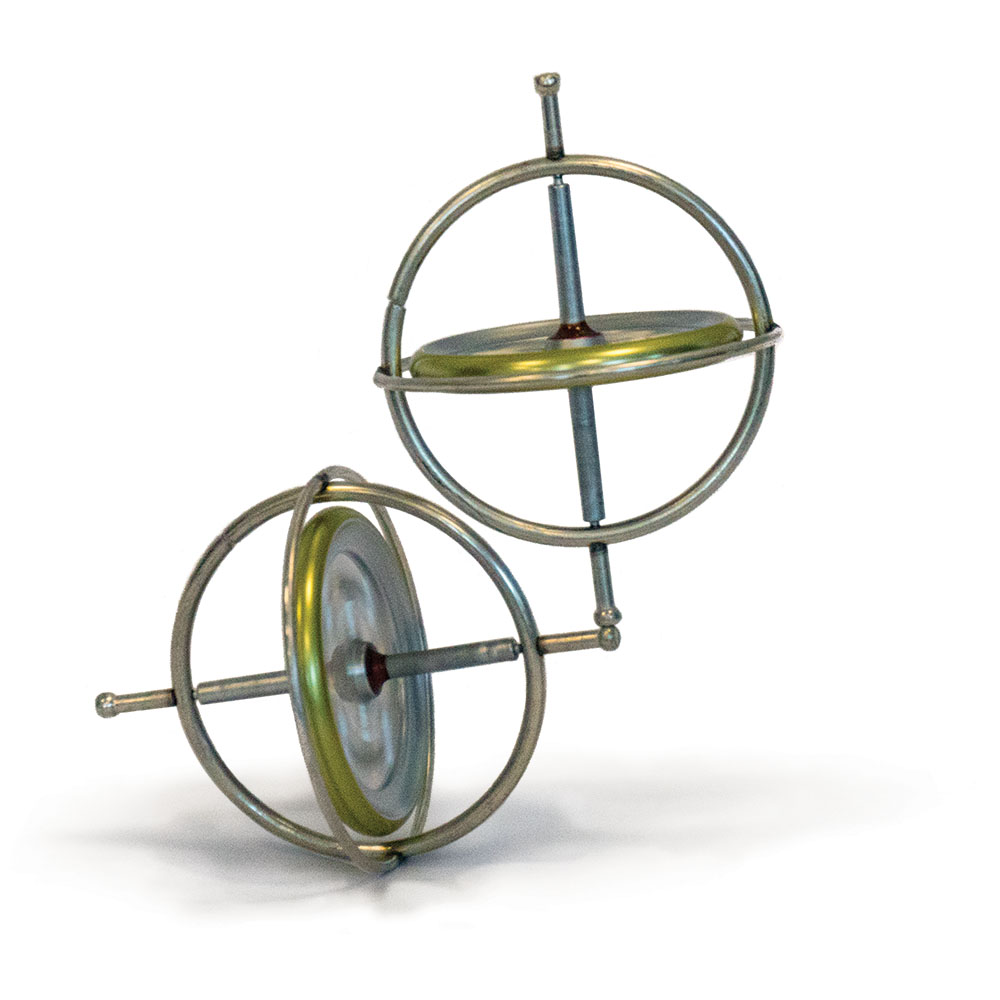
I learned this today. Gyroscopes work because of the conservation of angular momentum.
A gyroscope is useful to us when it is set in a gimbal because the axis of rotation on the gimble is free to assume any orientation, which means that the gyroscope at the center will move independently of the thing the gimbal is mounted to and stay level. This gives them thousands of uses.
The principle that a gyroscope uses was first discovered with spinning tops. It is basically a spinning top with a gimbal attached. Spinning tops had been discovered in ancient Greece, Rome, and China, but they were just used as toys. The gimbal was invented in Ancient Greece and China, although there is some doubt about the Greek story. Somewhere between 280 to 220 BC, Philo of Byzantium invented an inkpot that never spilled its ink. It was suspended on concentric rings that would rotate so that the inkpot did not. There is no contemporary evidence of this and it is only mentioned in a later Arabic text.
In China, in about 180 AD, Ding Huan came up with an incense burner that always stayed upright using concentric rings. There is evidence for this and hints that it might have been around in China from three centuries before.
The word “gyroscope” comes from ancient Greek. “Guros” means “circle” and “scopeo” means “to look”.
So, how does a gyroscope stay straight? It is easy to see if you spin a bicycle wheel that is suspended by strings at its axle. The wheel will continue to spin and will remain perfectly straight. If you cut one of the strings, so that the wheel is only suspended on one side, it will still be perfectly straight. Newton’s first law of motion says that a body in motion continues to move at a constant speed along a straight line unless acted upon by an unbalanced force. That means, if you spin the bicycle wheel it will continue to spin unless another force acts upon it. In this case, air resistance would slowly slow the wheel down. Gravity will also act on the wheel. If you cut the string holding up one side of a stationary wheel, gravity will act on it, it will fall down, yet pivot on the point tied to the string until it is horizontal, hanging from the string. If you do this with a spinning wheel, it won’t fall over because it is spinning. This is the reason. Gravity acts on the top of the wheel to pull it down, but the string is there so gravity pulls it to one side, let’s say the left. However, before that part of the wheel can fall to the left it spins to the bottom of the wheel. It still wants to fall to the left, but now it is at the bottom of the wheel. Because both the top and the bottom of the wheel are trying to fall in the same direction, they cancel each other out. This is called precession. And that is why the wheel stays steady.
In 1743, John Serson used a gyroscope to be able to locate the horizon on foggy days. In the 1860s, it became possible to motorize gyroscopes. If you spin the bicycle wheel in our example above, it will spin until air resistance stops it. That is not much use if you want a constantly level gyroscope. With motorized gyroscopes, they could spin indefinitely and had a whole host of uses.
One of the most common recent uses is to control autopilots on planes or guidance systems on missiles. Gyroscopes are placed at right angles to each other on a platform so that the platform stays completely stationary. This platform is placed within a gimbal and the gimbals have sensors on their axles. This means it is possible to detect which way the plane is turning because you have a completely rigid table to take measurements off. When this is added to an accelerometer, it is possible to know where a plane is pointing and how fast it is moving. Smartphones have a very miniaturized version of this in them. The gyroscope in your phone, though, doesn’t use a spinning disc. It uses vibration to cause the same effect because a vibrating object will continue to vibrate in the same plane.
So, a gyroscope works because the force that is trying to move the spinning disc out of its plane has already moved before it can act on the disc. In its new position, it is still trying to move the spinning disc off its plane, but in the same direction, and the two forces cancel each other out, making an extremely stable object. When this is set in a gimbal, you have a device that will always remain level when it is attached to a moving object. And this is what I learned today.
Sources
https://en.wikipedia.org/wiki/Gyroscope
https://science.howstuffworks.com/gyroscope.htm
